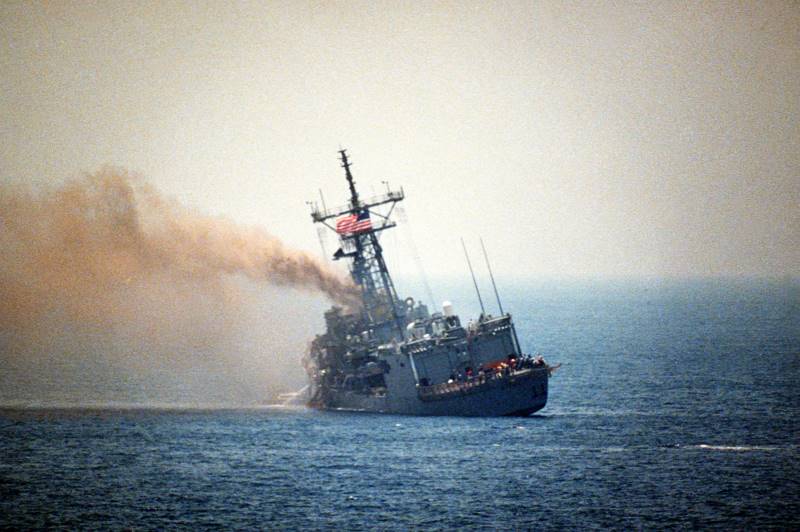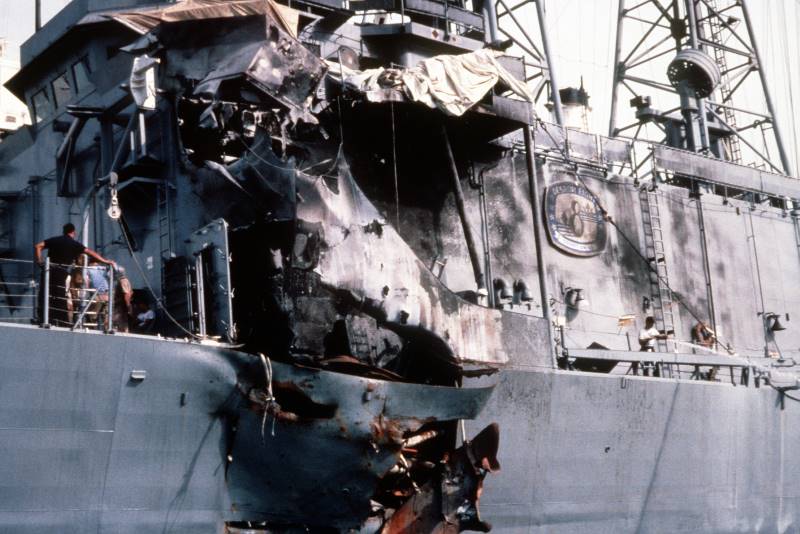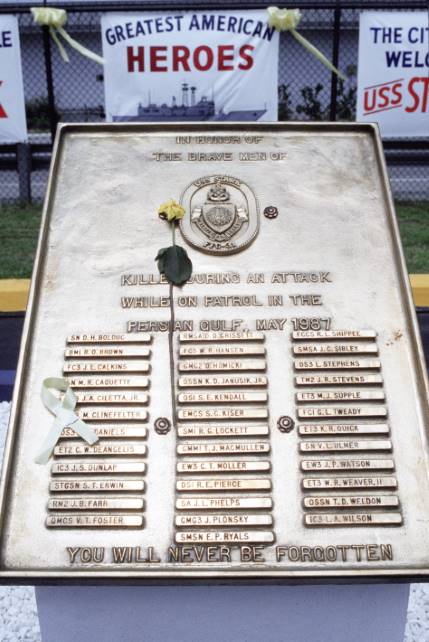Paul H. Smith(米軍の遠隔視能力者)による "USS Stark" 事件の 遠隔視実施状況の詳細+予知した光景のスケッチ
前置き
Paul H. Smith が、自身の遠隔視の中で最も優れた結果を出したものと自認しているのが "USS Stark" 事件の遠隔視実施。その詳細を本人が Web 記事にしているので紹介する。この遠隔視で作成したスケッチも含まれる(後述の pdf リンク)。

(By Service Depicted: NavyCommand Shown: N1601 - ID:DNSC8706412, Public Domain, https://commons.wikimedia.org/w/index.php?curid=48843)
予備知識
Wikipedia による事件の概要が下の折り畳み部分。
▼展開



By Service Depicted: NavyCommand Shown: N1601 - ID:DNSC8706412, Public Domain, https://commons.wikimedia.org/w/index.php?curid=48843
USSスターク事件は、イラン・イラク戦争中の1987年5月17日、ペルシャ湾で発生した。イラクのジェット機が米フリゲートUSSスタークに向けて2発のエクソセット・ミサイルを発射したのである。この攻撃により、合計37人の米海軍兵士が死亡または後に死亡し、21人が負傷した。 事件[編集]
USSスタークは中東機動部隊の一員で、イラン・イラク戦争排他的境界線付近のサウジアラビア沿岸をパトロールしていた。米国中央軍は攻撃機をイラクのダッソーミラージュF1戦闘機と断定した[1]が、その後の報道では、攻撃機はファルコン50ビジネスジェット機で、対艦作戦用にAM-39エグゾセットミサイル2発を搭載するためにレーダーとミサイルハードポイントを改造したものであったとされている。イラクが運用するミラージュF1のF1EQ-5型は、1発しか搭載できなかった。イラクは疑惑の目を避けるために、ペルシャ湾で秘密裏に写真偵察を行うために、民間用のマーキングを施した改良型ファルコンジェットを使用していた[2][3][4][5]。
当初は警戒していなかったが、22時9分、グレン・R・ブリンデル大尉は無線兵にメッセージを送るよう命じた: 「不明機、こちら米海軍戦艦、そちら078(度)方向12マイル。イラクのパイロットはこのメッセージに応答しなかった。艦長は2度目のメッセージの送信を命じたが、返信はなかった。22時10分、ブリンデルは、イラク航空機がスタークを狙い、サイラノIV火器管制レーダーをロックしたことを知らされた。イラク機はその後、1発目のエクソセットミサイルを艦から22マイル(35km)、2発目のエクソセットミサイルを15マイル(24km)から発射し、パイロットは左にバンクして撤退を開始した。
スタークの索敵レーダー、ESM、CIWSシステムは、着弾したミサイルを探知できなかった[6][1] 。起爆には失敗したが、ロケット燃料に引火して大火災を引き起こし、瞬く間に艦内の郵便局、倉庫、戦闘作戦センター(艦の兵器を制御する場所)に燃え広がった。
このミサイルは爆発し、フリゲート艦の左舷に10×15フィート(3.0×4.6m)の穴を残した。スタークの標準ミサイル防衛のための電子機器が停止し、ブリンデルは部下に応戦を命じることができなかった。AWACS機がまだこの地域におり、攻撃を目撃した直後、近くのサウジアラビアの空軍基地に迎撃のための航空機を派遣するよう無線連絡したが、地上管制官には出撃を命じる権限がなく、イラクのジェット機は無傷で去った。米海軍の交戦規則では、スタークは敵機に十分な警告を発した後に自衛することが認められていた[7]。
この攻撃で合計37人の乗組員が死亡し、最初の爆発と火災で29人が死亡した。その後、8名が負傷により死亡した。他の21名は傷から生還した[8]。
ブリンデルは、船体の左舷側の穴を水面上に保つため、右舷側の浸水を命じた。これはスタークの沈没を防ぐのに役立った。最初のミサイルが命中した後、ブリンデルはすぐに救難信号を発信した。それを受信したのは、この地域にいたUSSワデルと、バーレーンで乗組員の3分の2を解放していたUSSコニンガムだった。ワッデルとコニンガムは、スタークの乗組員にダメージコントロールと救援を提供するために到着した。国防総省によると、イランのヘリコプターがサウジアラビアの船に合流して救助活動を支援した[9]。
The USS Stark incident occurred during the Iran–Iraq War on 17 May 1987 in the Persian Gulf, when an Iraqi jet aircraft fired two Exocet missiles at the U.S. frigate USS Stark. A total of 37 United States Navy personnel were killed or later died as a result of the attack, and 21 were injured. Incident[edit]
USS Stark was part of the Middle East Task Force assigned to patrol off the Saudi Arabian coast near the Iran–Iraq War exclusion boundary. The United States Central Command identified the attacking aircraft as an Iraqi Dassault Mirage F1 fighter.[1] Later reports asserted that the attacking aircraft was a Falcon 50 business jet which had been modified with a radar and missile hardpoints to carry two AM-39 Exocet missiles for anti-shipping operations. The F1EQ-5 variant of the Mirage F1 operated by Iraq was capable of carrying only one Exocet. Iraq had used modified Falcon jets in civilian markings to conduct covert photographic reconnaissance in the Persian Gulf to avoid attracting suspicion.[2][3][4][5]
Initially not alarmed, at 22:09 Captain Glenn R. Brindel ordered a radioman to send the message: "Unknown aircraft, this is U.S. Navy warship on your 078 (degrees) for twelve miles. Request you identify yourself".[6] The Iraqi pilot did not respond to the message. The ship's captain ordered a second message sent, to which there was no reply. At 22:10 Brindel was informed the Iraqi aircraft had targeted his ship, locking his Cyrano-IV fire-control radar onto Stark. The Iraqi aircraft then fired the first Exocet missile 22 mi (35 km) from the ship and the second Exocet from 15 mi (24 km); the pilot then banked left and began to withdraw.
Stark's search radar, ESM and CIWS systems failed to detect the incoming missiles.[6][1] The first Exocet missile struck the port side of the ship near the bridge. Although it failed to detonate, rocket fuel ignited and caused a large fire that quickly spread throughout the ship's post office, storeroom and the combat operations center (where the ship's weapons are controlled).
The second Exocet also struck the port side, 30 seconds later.[1] This missile detonated, leaving a 10 by 15 ft (3.0 by 4.6 m) hole in the frigate's left side. Electronics for Stark's Standard Missile defense went out and Brindel could not order his men to return fire. An AWACS plane was still in the area and just after witnessing the attack, radioed a nearby Saudi Arabian airbase to send aircraft for an interception but the ground controllers did not have the authority to order a sortie and the Iraqi jet left unharmed. The US Navy's rules of engagement allowed Stark to defend herself after sufficiently warning the hostile aircraft.[7]
A total of 37 crew were killed in the attack, 29 from the initial explosion and fire, including two lost at sea. Eight later died from their injuries. Twenty-one others survived their wounds.[8]
Brindel ordered the starboard side flooded to keep the hole on the hull's port side above water. This helped prevent Stark from sinking. Brindel quickly dispatched a distress call after the first missile hit. It was received by USS Waddell, which was in the area and USS Conyngham with two-thirds of its crew on liberty in Bahrain. Waddell and Conyngham arrived to provide damage control and relief to Stark's crew. According to the Pentagon, an Iranian helicopter joined a Saudi Arabian vessel to aid in rescue operations.[9]
出典
USS Stark Remote Viewing Session (typescript) | RVIS https://rviewer.com/uss-stark-remote-viewing-session-typescript/
和訳(DeepL)
USSスターク遠隔視セッション(タイプスクリプト) 7-9分
以下に埋め込まれているのは、私、ポール・H・スミスUSA大尉(当時)が、50時間先の未来に起こるはずのない出来事に対して行ったリモート・ビューイング・セッションのタイプスクリプトである。モニターであるエド・デイムズが出したタスクはおおよそ次のようなものだった: 「今後数日のうちに、われわれが知るべき最も重要な出来事を説明せよ。これは、ジョージ・G・ミード砦にあるスターゲートのリモート・ビューイング・ユニットで「オープン・タスキング」と呼ばれていたもので、何が出てくるかわからない、一種のサイキックな「釣り探検」であった。
インゴ・スワンとハロルド・E・プソフ博士から学んだ座標リモート・ビューイングの方法を使って、私は1987年5月15日の朝10時23分にデイムズの指示でセッションを開始した。セッションが終わったのは日本時間の午前11時36分、合計1時間13分だった。私がこのセッションで得るべきものをすべて得たと思った頃、デイムスは、タスキングが何を生み出すかについて自分なりの先入観を持っていたようで、セッションを打ち切った。彼は、私が「オフ」であった(つまり、リモート・ビューイングのシグナルに同調していなかったため、有益な情報が得られなかった)ことを指摘した。彼は私に、自分のセッションを金庫の引き出しにファイルしておくように指示した。その日の終わりに、私たちは全員オフィスを出て、週末に帰宅した。 ポール・H・スミスによるUSSスタークのリモート・ビューイング・セッション USSスタークへの攻撃に関するワシントン・ポストの記事。ポール・H・スミスによるリモート・ビューイング・セッションと比較する。(クリックで拡大)
月曜の朝、子供たちの学校へ行く支度をしていると、作戦・訓練担当官のフレッド・"スキップ"・アトウォーター少佐から電話があり、金曜のセッションの場所を聞かれた。「金庫の引き出しの中だよ。なぜ聞くんだ?セッションは休みだったんだ。スキップの返事はこうだった: 「今朝の新聞を見ていないようだな!」だった。私はワシントン・ポスト紙を取り出し、右側に表示されている一面を見た。イラクのミサイルが米軍のフリゲート艦を炎上させ、死傷者を出した。
��このニュース記事は、私が2日前のリモート・ビューイング・セッションで知覚し、報告した情報を実質的に裏付けるものだった。その月曜日の朝、私の指揮官は、そのセッションの完全で正確なタイプスクリプトを作成するよう私に要求した(セッションに深く没頭しているとき、私の手書き文字はしばしば読みづらくなるからだ)。私は調査結果の要約を添付した。残念ながら、その要約のコピーは見つかっていない。しかし、このセッションがそれを物語っている。ここにリンクされている攻撃に関する説明や分析と比較して、セッションがどれほど正確であったかは、以下の記録から判断できる。
原文引用
USS Stark Remote Viewing Session (typescript) 7–9 minutes
Embedded below is the typescript of the remote viewing session done by me, then-Captain Paul H. Smith USA against a target event that didn’t occur until 50 hours into the future. The tasking, as formulated by the monitor, Ed Dames was approximately: “Describe the most important event for us to know about in the next few days.” This constituted what we referred to in the Star Gate remote viewing unit at Ft. George G. Meade as an “open tasking”—a sort of psychic “fishing expedition,” just to see what might turn up.
Using the coordinate remote viewing methodology I had learned from Ingo Swann and Dr. Harold E. Puthoff, I started the session at Dames’ direction at 10:23 in the morning on 15 May 1987. The session ended at 11:36 AM EDT, for a total of one hour and thirteen minutes. About the time I felt I had got all that I was going to, Dames, who had his own preconceptions about what the tasking would produce, ended the session. He opined that I was “off” (that is, that I had not tuned into the remote viewing signal and thus had produced no useful information). He instructed me to go ahead and file my session in my safe drawer. At the end of the day, we all departed the office and went home for the weekend. USS Stark Remote Viewing Session by Paul H. Smith Washington Post story about the attack on the USS Stark. Compare to the remote viewing session by Paul H. Smith. (Click to enlarge)
On Monday morning, as I was getting my kids ready for school, our operations and training officer, Capt. Fred “Skip” Atwater phoned to ask where my Friday session was. “It’s in my safe drawer. Why do you ask? I was off on the session.” Skip’s response was: “I guess you haven’t seen this morning’s paper!” I retrieved my copy of the Washington Post and looked at the front page, which you can see displayed to the right. It read “Iraqi Missile Sets US Frigate Ablaze, Causing Casualties.”
The news story substantially confirmed the information I had perceived and reported in my remote viewing session from two days before. That Monday morning my commander requested I prepare a complete, accurate typescript of the session (since my handwriting often becomes hard to read when I am deeply engrossed in a session), so that it could be transmitted up the chain of command at the Defense Intelligence Agency. I included a summary of my findings. Unfortunately I have not found a copy of the summary. But the session speaks for itself. You can judge from the transcript below how accurate the session in comparison to an account and analysis of the attack linked here.
この遠隔視で記録された内容+スケッチ
https://rviewer.com/wp-content/uploads/2021/04/Stark_Session_typescript_01.pdf
予備:本サイトから pdf(0.2MB) を download
(2024-07-10)